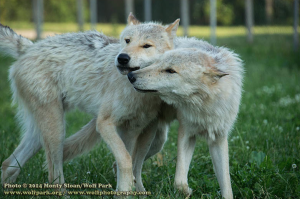 Is there a behavioral concept that we can describe as dominance between dogs or between dogs and people? As I had mentioned in a previous blog “Dominance and pack leadership in dogs – Controversial and still misunderstood“, there seems to be a dividing line between two camps. Many dog guardians and professionals believe that dogs define every interaction with others in terms of leadership and follower, of dominant and submissive (Millan, 2008; Monks of New Skete, 1978). Others believe that when we base our relationship with dogs on the idea that we need to be the ‘leader of the pack’, we increase the chances of antagonistic exchanges, which can trigger aggressive behaviors in the dog (Donaldson, 1996, O’Heare, 2007). In this latter camp, the concept of dominance in dogs has been questioned (Bradshaw & al., 2009) to the point that many now believe that it simply does not apply to dogs at all (or to wolves). In other species, such as horses, cattle, wild African dogs or even humans, the concept of dominance is a valid way to describe certain aspects of a relationship between two individuals. More and more studies today suggest that dominance does indeed play a role in dog-dog relationships and is also likely to influence human-dog relationships (Trisko, 2011; Bonnani, 2012; van der Borg & al., 2012; Ákos, 2014, Shilder & al., 2014). This subject is complex and there is too much in the literature to present in just one blog, but as I stumbled upon new studies on the topic, I wanted to present some of the most interesting findings and theories on dominance in the hopes that we can open the debate and rehabilitate the term.
Is there a behavioral concept that we can describe as dominance between dogs or between dogs and people? As I had mentioned in a previous blog “Dominance and pack leadership in dogs – Controversial and still misunderstood“, there seems to be a dividing line between two camps. Many dog guardians and professionals believe that dogs define every interaction with others in terms of leadership and follower, of dominant and submissive (Millan, 2008; Monks of New Skete, 1978). Others believe that when we base our relationship with dogs on the idea that we need to be the ‘leader of the pack’, we increase the chances of antagonistic exchanges, which can trigger aggressive behaviors in the dog (Donaldson, 1996, O’Heare, 2007). In this latter camp, the concept of dominance in dogs has been questioned (Bradshaw & al., 2009) to the point that many now believe that it simply does not apply to dogs at all (or to wolves). In other species, such as horses, cattle, wild African dogs or even humans, the concept of dominance is a valid way to describe certain aspects of a relationship between two individuals. More and more studies today suggest that dominance does indeed play a role in dog-dog relationships and is also likely to influence human-dog relationships (Trisko, 2011; Bonnani, 2012; van der Borg & al., 2012; Ákos, 2014, Shilder & al., 2014). This subject is complex and there is too much in the literature to present in just one blog, but as I stumbled upon new studies on the topic, I wanted to present some of the most interesting findings and theories on dominance in the hopes that we can open the debate and rehabilitate the term.
Before we go any further in this discussion, let’s define the concept of dominance. I often hear people refer to their dog as being dominant. But is dominance a character trait? The term ‘dominance’ has been used by scientists to describe the social relationships between animals living in the same group. The members of any social group each have unique characteristics. Some are physically stronger than others, they can be faster, have more stamina, they can also be older, etc. As a result, certain individuals will have predictable advantages over others when competing over resources. Relationships are often uneven, so when animal A gets the upper hand over animal B in most interactions, we can say that animal A is dominant over animal B. But B may also be dominant over C, so if dominance was a behavior trait, would we describe B as dominant or subordinate?
When studying hierarchy in a group, scientists will focus on four main questions to establish the rank between the animals:
- Does animal A show ‘dominant’ typical behaviors towards animal B more often than the reverse? The opposite is equally valid: does animal B show typical ‘submissive’ behaviors towards animal A more often than the reverse?
- Is the outcome of the interactions between the individuals the same in different contexts? So if A generally gets the mate over B, does A also get access to the food over B?
- Are these behaviors consistent over time? If we come back several weeks or months, will we still see the same interactions between A and B?
- When certain relevant behaviors are always performed in one direction only, like always from A to B, but never from B to A, this is said to be a formal dominance signal or meta-communicative signal. The animal is conveying either dominance or submission. This type of behavioral display has been found in many species like wolves and certain primates. For instance, a wolf may adopt a high posture towards subordinates but will never adopt a low posture, displaying submission towards the same animal.
 When we think of dominance-based relationship, we tend to think of high-ranking animals routinely showing their power and strength to the lower ranking animals to reinforce their status. In reality, dominant relationships are primarily established by low ranking individuals showing formal submissive signals to high-ranking animals, in recognition of their supremacy. This helps reduce the number of conflicts in the group. This also explains why wolves in the wild, where packs are formed by a mating pair and their offspring, have very few conflicts. Problems between animals generally occur when the differences between the animals are too small. If we make the comparison to humans, a young child will rarely question a parent or grandparent but will constantly argue and fight with a brother or sister. When the children become young adults, the differences with their parents are now reduced and the increase in conflicts with the adults will eventually lead them to leave.
When we think of dominance-based relationship, we tend to think of high-ranking animals routinely showing their power and strength to the lower ranking animals to reinforce their status. In reality, dominant relationships are primarily established by low ranking individuals showing formal submissive signals to high-ranking animals, in recognition of their supremacy. This helps reduce the number of conflicts in the group. This also explains why wolves in the wild, where packs are formed by a mating pair and their offspring, have very few conflicts. Problems between animals generally occur when the differences between the animals are too small. If we make the comparison to humans, a young child will rarely question a parent or grandparent but will constantly argue and fight with a brother or sister. When the children become young adults, the differences with their parents are now reduced and the increase in conflicts with the adults will eventually lead them to leave.
For the same reason, when dogs living in the same household are of the same sex and similar in size and age, fights between them are likely to be more frequent and violent than when the differences between dogs is greater. This is where it gets really sticky. Many of our conclusions about how we should treat our dogs come from dominance theories based on the observation of captive wolves, where conflicts between the animals are more frequent than in the wild. Today, more scientists seem to agree that there are significant differences between group dynamics of captive versus wild wolves. In the same way, more research is showing similar differences between feral dogs and dogs living in the same household. Recent research is now showing that social structure similar to wolves does in fact exist in feral dogs (Bonnani & al., 2014; Caffazzo & al. 2010). So does that mean that the so-called ‘dominance theory’ still applied today by trainers is correct? Absolutely not! As we’ll see, social dynamics between dogs are complex and cannot be reduced to a simplistic application of a set of rules and constraints designed to enforce some type of social order in the household.
A study of dogs in a daycare found that the dogs had formed linear hierarchies based on submissive and aggressive behaviors (Trisko, 2011). Age was found to be the main factor determining which animals were dominant. Younger dogs regularly submitted to older dogs. Dominance relationship were also more common in same-sex pairs rather than in cross-sex pairs. Interestingly, these dogs displayed dominance/subordinate interactions even though aggressive behavior was discouraged and redirected by the daycare staff and all the dogs had been evaluated prior to being accepted within the facility; as showing little to no aggression towards other dogs. So here again, aggressive displays were not the deciding component of the interaction. Another interesting result of this study is that dominant relationships were found in only a third of all possible pairs, so formal dominance can describe some, but certainly not all social relationships in a group of dogs. Four different types of relationships were identified:
- Formal relationships: affiliation and one-way submission (22%)
- Egalitarian relationships: affiliation but no dominance relationship (21%)
- Agonistic relationships: one-way submission but no affiliation (8%)
- Non-interactive relationship: no submission or affiliation (50%).
In this context the social behavior of the dogs was not only regulated by who was stronger, faster, bolder or anxious but could have also been influenced by other factors: learning and motivation. It’s possible that when humans promote and reinforce a tolerant and friendly social attitude, the dogs are more likely to form egalitarian relationships. In preschools where teachers discourage physical aggression, the children learn to solve their conflicts with words and over time, fights between the children are reduced in frequency and severity (Roseth & al., 2007). It’s possible that, just as children, dogs are capable of learning to use affiliation over physical aggression. Through associative learning, some animals will learn how to dominate another. Others become ‘trained losers’ after losing a conflict and will start exhibiting submissive behaviors towards certain individuals. Motivation will also influence the interaction as the value of the resource the dogs are contemplating will also change depending on how hungry, tired or contempt they are.
 It’s interesting to note that as much as we struggle to talk openly about dominance in dogs, the concepts of social power, dominance and submission are considered fundamental principles of personal relationships in humans. Studies have revealed that we can assess who dominates a relationship within the first few minutes, even before any word has been spoken. Much like other animals, humans will show power by physically dominating the other, sitting in a straight-up manner or standing over, with the chin up, direct and extended eye contact and an open body posture. On the opposite side, submissive people will make themselves smaller, adopt a lower spatial position and break eye contact (for more on this subject I invite you to watch the TED talk video at the bottom of this blog). These similarities may have helped dogs and humans understand each other and interpret each other’s body positions in terms of dominance/submissive displays.
It’s interesting to note that as much as we struggle to talk openly about dominance in dogs, the concepts of social power, dominance and submission are considered fundamental principles of personal relationships in humans. Studies have revealed that we can assess who dominates a relationship within the first few minutes, even before any word has been spoken. Much like other animals, humans will show power by physically dominating the other, sitting in a straight-up manner or standing over, with the chin up, direct and extended eye contact and an open body posture. On the opposite side, submissive people will make themselves smaller, adopt a lower spatial position and break eye contact (for more on this subject I invite you to watch the TED talk video at the bottom of this blog). These similarities may have helped dogs and humans understand each other and interpret each other’s body positions in terms of dominance/submissive displays.
So does the concept of dominance exist in dogs? Yes it does. Dominance between animals, including dogs is a validated scientific concept that helps describe and understand certain social dynamics between animals. But contrary to what has been advocated, we don’t gain stability in the group by forcefully exerting dominance. Accepting the concept of dominance does not justify the use dominant signals such as the ‘alpha roll’. Those methods are dangerous and promote aggression. Proper socialization and reward based training can encourage in the dog the display of appropriate formal submissive signals towards their human and contribute to the development of a relationship based on trust and mutual respect. When denouncing certain long held beliefs about dominance, we don’t need to take another extreme view and denounce its existence altogether. The concept of dominance certainly doesn’t explain all of our dogs’ social interactions, but it does offer a valid method to describe certain types of interactions.
Jennifer Cattet Ph.D.


i’ve got a problem with the video. I wonder if it isn’t a cultural thing — bcause to me much of what we described as ‘dominant’ body language/postures looked threatening and bullying.
I wonder if he experiments were reproduced in different cultres whether the same results would be foind? I know that as an interviewer, I would not be favouring the brash candidate. Though I suppose that it also depends on what [osition you are applying for? Does the “Business World” favour the brash, over-bearing people? Maybe that is why Idid not go into that live of business.
Excellent article – thank you!
“Does the concept of dominance apply to dogs?” … between members of the same species, absolutely, but does the scientific concept of dominance apply between members of two different species? This is the big bone of contention for the ‘traditional’ versus ‘force free’ camps, and confuses the lay-person.
One example of human dominance relationships changing as we grow or age: the incredible difficulty of grown children trying to control elderly parents, such as the Taking Away Of The Car Keys.
Interesting article and quite readable.
However, here’s a place that needs some editing: “…dominance and submission are considered fundamental principals of personal relationships in humans….” The word “principals” here is the wrong word. It should be “principles”.
FINALLY someone who has the gall to cite recent sources that SUPPORT the theory of dominance, instead of jumping onto the self-validating bandwagon of the strictly positive reinforcement practitioners.
It simply supports dominance in some cases between the same species. Yes, dominance and intimidation exists between some interactions, but that does not mean that it has a place in training and teaching them (or children for that matter). And this article states that as well.
Dominance exists in dogs, yes. However, the AVBA says that dominance theory has no place in training protocols.